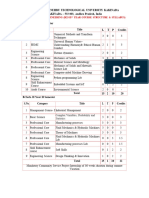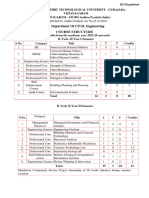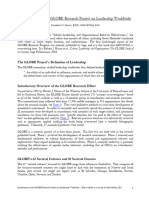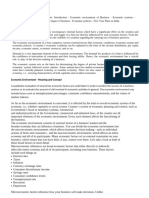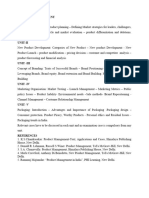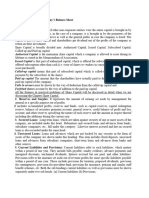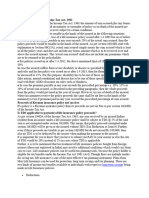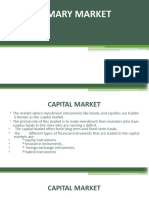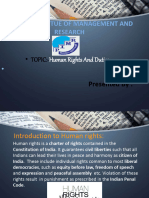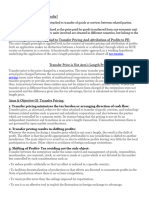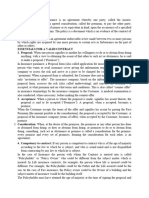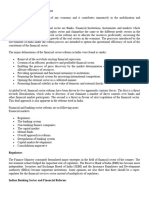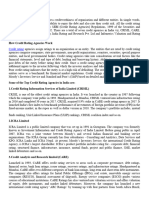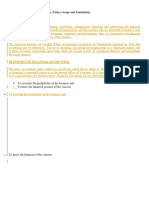B Tech-IT
Uploaded by
mba departmentB Tech-IT
Uploaded by
mba departmentwww.android.universityupdates.in | www.universityupdates.in | https://telegram.
me/jntukkd
JAWAHARLAL NEHRU TECHNOLOGICAL UNIVERSITY KAKINADA
KAKINADA – 533 003, Andhra Pradesh, India
B.TECH- IT (R23 IInd YEAR COURSE STRUCTURE & SYLLABUS)
B.Tech.– II Year I Semester
S.No. Category Title L T P Credits
1 BS&H Discrete Mathematics & 3 0 0 3
Graph Theory
2 BS&H Universal human values – 2 1 0 3
understanding harmony and
Ethical human conduct
3 Engineering Digital Logic &Computer 3 0 0 3
Science Organization
4 Professional Advanced Data Structures & 3 0 0 3
Core Algorithms
5 Professional Object Oriented Programming 3 0 0 3
Core Through Java
6 Professional Advanced Data Structures Lab 0 0 3 1.5
Core
7 Professional Object Oriented Programming 0 0 3 1.5
Core Through Java Lab
8 Skill Python Programming 0 1 2 2
Enhancement
course
9 Audit Course Environmental Science 2 0 0 -
Total 16 2 8 20
B.Tech.– II Year II Semester
S.No. Category Title L T P Credits
1 Management Course- I Optimization Techniques 2 0 0 2
2 Engineering Science/ Probability & Statistics 3 0 0 3
Basic Science
3 Professional Core Operating Systems 3 0 0 3
4 Professional Core Database Management 3 0 0 3
Systems
5 Professional Core Software Engineering 3 0 0 3
6 Professional Core Operating Systems & Software 0 0 3 1.5
Engineering Lab
7 Professional Core Database Management 0 0 3 1.5
Systems Lab
8 Skill Enhancement Python with DJango 0 1 2 2
Course
Design Thinking & Innovation
9 BS&H 1 0 2 2
Total 15 1 10 21
Mandatory Community Service Project Internship of 08weeks duration during
summer vacation
www.android.previousquestionpapers.com | www.previousquestionpapers.com | https://telegram.me/jntukkd
www.android.universityupdates.in | www.universityupdates.in | https://telegram.me/jntukkd
JAWAHARLAL NEHRU TECHNOLOGICAL UNIVERSITY KAKINADA
KAKINADA – 533 003, Andhra Pradesh, India
B.TECH- IT (R23 IInd YEAR COURSE STRUCTURE & SYLLABUS)
II Year I Semester
L T P C
3 0 0 3
DISCRETE MATHEMATICS AND GRAPH THEORY
Course Objectives:
To introduce the students to the topics and techniques of discrete methods and
combinatorial reasoning.
To introduce a wide variety of applications. The algorithmic approach to the solution
of problems is fundamental in discrete mathematics, and this approach reinforces the
close ties between this discipline and the area of computer science.
Course Outcomes: At the end of the course students will be able to
1. Build skills in solving mathematical problems (L3)
2. Comprehend mathematical principles and logic (L4)
3. Demonstrate knowledge of mathematical modeling and proficiency in using
mathematical software (L6)
4. Manipulate and analyze data numerically and/or graphicallysing appropriate Software
(L3)
5. How to communicate effectively mathematical ideas/results verbally or in writing
(L1)
UNIT–I: Mathematical Logic:
Propositional Calculus: Statements and Notations, Connectives, Well Formed Formulas,
Truth Tables, Tautologies, Equivalence of Formulas, Duality Law, Tautological Implications,
Normal Forms, Theory of Inference for Statement Calculus, Consistency of Premises,
Indirect Method ofProof, Predicate Calculus: Predicates, Predicative Logic, Statement
Functions, Variables and Quantifiers, Free and Bound Variables, Inference Theory for
Predicate Calculus.
UNIT-II: Set Theory:
Sets: Operations on Sets, Principle of Inclusion-Exclusion, Relations: Properties, Operations,
Partition and Covering, Transitive Closure, Equivalence, Compatibility and Partial Ordering,
Hasse Diagrams, Functions: Bijective, Composition, Inverse, Permutation, and Recursive
Functions, Lattice and its Properties.
UNIT-III: Combinatorics and Recurrence Relations:
Basis of Counting, Permutations, Permutations withRepetitions, Circular and Restricted
Permutations, Combinations, RestrictedCombinations, Binomial and Multinomial
Coefficients and Theorems.
Recurrence Relations:
www.android.previousquestionpapers.com | www.previousquestionpapers.com | https://telegram.me/jntukkd
www.android.universityupdates.in | www.universityupdates.in | https://telegram.me/jntukkd
JAWAHARLAL NEHRU TECHNOLOGICAL UNIVERSITY KAKINADA
KAKINADA – 533 003, Andhra Pradesh, India
B.TECH- IT (R23 IInd YEAR COURSE STRUCTURE & SYLLABUS)
Generating Functions, Function of Sequences, Partial Fractions, Calculating Coefficient of
Generating Functions, Recurrence Relations, Formulation as Recurrence Relations, Solving
Recurrence Relations by Substitution and Generating Functions, Method of Characteristic
Roots, Solving Inhomogeneous Recurrence Relations
UNIT-IV: Graph Theory:
Basic Concepts, Graph Theory and its Applications, Subgraphs, Graph Representations:
Adjacency and Incidence Matrices, Isomorphic Graphs, Paths and Circuits, Eulerian and
Hamiltonian Graphs,
Unit-V: Multi Graphs
Multigraphs, Bipartite and Planar Graphs, Euler’s Theorem, Graph Colouring and Covering,
Chromatic Number, Spanning Trees, Prim’s and Kruskal’s Algorithms, BFS and DFS
Spanning Trees.
TEXT BOOKS:
1. Discrete Mathematical Structures with Applications to Computer Science, J. P.
Tremblay and P. Manohar, Tata McGraw Hill.
2. Elements of Discrete Mathematics-A Computer Oriented Approach, C. L.Liu and D.
P. Mohapatra, 3rd Edition, Tata McGraw Hill.
3. Theory and Problems of Discrete Mathematics, Schaum’s Outline Series, Seymour
Lipschutz and Marc Lars Lipson, 3rd Edition, McGraw Hill.
REFERENCE BOOKS:
1. Discrete Mathematics for Computer Scientists and Mathematicians, J. L.Mott, A.
Kandel and T. P. Baker, 2nd Edition, Prentice Hall of India.
2. Discrete Mathematical Structures, Bernand Kolman, Robert C. Busby andSharon
Cutler Ross, PHI.
3. Discrete Mathematics, S. K. Chakraborthy and B.K. Sarkar, Oxford, 2011.
4. Discrete Mathematics and its Applications with Combinatorics and GraphTheory, K.
H. Rosen, 7th Edition, Tata McGraw Hill.
www.android.previousquestionpapers.com | www.previousquestionpapers.com | https://telegram.me/jntukkd
www.android.universityupdates.in | www.universityupdates.in | https://telegram.me/jntukkd
JAWAHARLAL NEHRU TECHNOLOGICAL UNIVERSITY KAKINADA
KAKINADA – 533 003, Andhra Pradesh, India
B.TECH- IT (R23 IInd YEAR COURSE STRUCTURE & SYLLABUS)
II Year I Semester L T P C
2 1 0 3
UNIVERSAL HUMAN VALUES – UNDERSTANDING HARMONY AND
ETHICAL HUMAN CONDUCT
Course Objectives:
To help the students appreciate the essential complementary between 'VALUES' and
'SKILLS' to ensure sustained happiness and prosperity which are the core aspirations
of all human beings.
To facilitate the development of a Holistic perspective among students towards life
and profession as well as towards happiness and prosperity based on a correct
understanding of the Human reality and the rest of existence. Such holistic
perspective forms the basis of Universal Human Values and movement towards
value-based living in a natural way.
To highlight plausible implications of such a Holistic understanding in terms of
ethical human conduct, trustful and mutually fulfilling human behaviour and mutually
enriching interaction with Nature.
Course Outcomes:
Define the terms like Natural Acceptance, Happiness and Prosperity (L1, L2)
Identify one’s self, and one’s surroundings (family, society nature) (L1, L2)
Apply what they have learnt to their own self in different day-to-day settings in
real life (L3)
Relate human values with human relationship and human society. (L4)
Justify the need for universal human values and harmonious existence (L5)
Develop as socially and ecologically responsible engineers (L3, L6)
Course Topics
The course has 28 lectures and 14 tutorials in 5 modules. The lectures and tutorials are of 1-
hour duration. Tutorial sessions are to be used to explore and practice what has been
proposed during the lecture sessions.
The Teacher’s Manual provides the outline for lectures as well as practice sessions. The
teacher is expected to present the issues to be discussed as propositions and encourage the
students to have a dialogue.
UNIT I Introduction to Value Education (6 lectures and 3 tutorials for practice
session)
Lecture 1: Right Understanding, Relationship and Physical Facility (Holistic
Development and the Role of Education)
Lecture 2: Understanding Value Education
Tutorial 1: Practice Session PS1 Sharing about Oneself
Lecture 3: self-exploration as the Process for Value Education
Lecture4: Continuous Happiness and Prosperity – the Basic Human
Aspirations
Tutorial 2: Practice Session PS2 Exploring Human Consciousness
Lecture 5: Happiness and Prosperity – Current Scenario
Lecture 6: Method to Fulfill the Basic Human Aspirations
www.android.previousquestionpapers.com | www.previousquestionpapers.com | https://telegram.me/jntukkd
www.android.universityupdates.in | www.universityupdates.in | https://telegram.me/jntukkd
JAWAHARLAL NEHRU TECHNOLOGICAL UNIVERSITY KAKINADA
KAKINADA – 533 003, Andhra Pradesh, India
B.TECH- IT (R23 IInd YEAR COURSE STRUCTURE & SYLLABUS)
Tutorial 3: Practice Session PS3 Exploring Natural Acceptance
UNIT II Harmony in the Human Being (6 lectures and 3 tutorials for practice session)
Lecture 7: Understanding Human being as the Co-existence of the self and the
body.
Lecture 8: Distinguishing between the Needs of the self and the body
Tutorial 4: Practice Session PS4 Exploring the difference of Needs of self and
body.
Lecture 9: The body as an Instrument of the self
Lecture 10: Understanding Harmony in the self
Tutorial 5: Practice Session PS5 Exploring Sources of Imagination in the self
Lecture 11: Harmony of the self with the body
Lecture 12: Programme to ensure self-regulation and Health
Tutorial 6: Practice Session PS6 Exploring Harmony of self with the body
UNIT III Harmony in the Family and Society (6 lectures and 3 tutorials for practice
session)
Lecture 13: Harmony in the Family – the Basic Unit of Human Interaction
Lecture 14: 'Trust' – the Foundational Value in Relationship
Tutorial 7: Practice Session PS7 Exploring the Feeling of Trust
Lecture 15: 'Respect' – as the Right Evaluation
Tutorial 8: Practice Session PS8 Exploring the Feeling of Respect
Lecture 16: Other Feelings, Justice in Human-to-Human Relationship
Lecture 17: Understanding Harmony in the Society
Lecture 18: Vision for the Universal Human Order
Tutorial 9: Practice Session PS9 Exploring Systems to fulfil Human Goal
UNIT IV Harmony in the Nature/Existence (4 lectures and 2 tutorials for practice
session)
Lecture 19: Understanding Harmony in the Nature
Lecture 20: Interconnectedness, self-regulation and Mutual Fulfilment among
the Four Orders of Nature
Tutorial 10: Practice Session PS10 Exploring the Four Orders of Nature
Lecture 21: Realizing Existence as Co-existence at All Levels
Lecture 22: The Holistic Perception of Harmony in Existence
Tutorial 11: Practice Session PS11 Exploring Co-existence in Existence.
UNIT V Implications of the Holistic Understanding – a Look at Professional Ethics (6
lectures and 3 tutorials for practice session)
Lecture 23: Natural Acceptance of Human Values
Lecture 24: Definitiveness of (Ethical) Human Conduct
Tutorial 12: Practice Session PS12 Exploring Ethical Human Conduct
Lecture 25: A Basis for Humanistic Education, Humanistic Constitution and
Universal Human Order
Lecture 26: Competence in Professional Ethics
Tutorial 13: Practice Session PS13 Exploring Humanistic Models in Education
Lecture 27: Holistic Technologies, Production Systems and Management
Models-Typical Case Studies
Lecture 28: Strategies for Transition towards Value-based Life and Profession
www.android.previousquestionpapers.com | www.previousquestionpapers.com | https://telegram.me/jntukkd
www.android.universityupdates.in | www.universityupdates.in | https://telegram.me/jntukkd
JAWAHARLAL NEHRU TECHNOLOGICAL UNIVERSITY KAKINADA
KAKINADA – 533 003, Andhra Pradesh, India
B.TECH- IT (R23 IInd YEAR COURSE STRUCTURE & SYLLABUS)
Tutorial 14: Practice Session PS14 Exploring Steps of Transition towards
Universal Human Order
Practice Sessions for UNIT I – Introduction to Value Education
PS1 Sharing about Oneself
PS2 Exploring Human Consciousness
PS3 Exploring Natural Acceptance
Practice Sessions for UNIT II – Harmony in the Human Being
PS4 Exploring the difference of Needs of self and body
PS5 Exploring Sources of Imagination in the self
PS6 Exploring Harmony of self with the body
Practice Sessions for UNIT III – Harmony in the Family and Society
PS7 Exploring the Feeling of Trust
PS8 Exploring the Feeling of Respect
PS9 Exploring Systems to fulfil Human Goal
Practice Sessions for UNIT IV – Harmony in the Nature (Existence)
PS10 Exploring the Four Orders of Nature
PS11 Exploring Co-existence in Existence
Practice Sessions for UNIT V – Implications of the Holistic Understanding – a Look at
Professional Ethics
PS12 Exploring Ethical Human Conduct
PS13 Exploring Humanistic Models in Education
PS14 Exploring Steps of Transition towards Universal Human Order
READINGS:
Textbook and Teachers Manual
a. The Textbook
R R Gaur, R Asthana, G P Bagaria, A Foundation Course in Human Values and Professional
Ethics, 2nd Revised Edition, Excel Books, New Delhi, 2019. ISBN 978-93-87034-47-1
b. The Teacher’s Manual
R R Gaur, R Asthana, G P Bagaria,Teachers’ Manual for A Foundation Course in Human
Values and Professional Ethics, 2nd Revised Edition, Excel Books, New Delhi, 2019. ISBN
978-93-87034-53-2
Reference Books
1. JeevanVidya: EkParichaya, A Nagaraj, JeevanVidyaPrakashan, Amarkantak, 1999.
2. Human Values, A.N. Tripathi, New Age Intl. Publishers, New Delhi, 2004.
3. The Story of Stuff (Book).
4. The Story of My Experiments with Truth - by Mohandas Karamchand Gandhi
5. Small is Beautiful - E. F Schumacher.
6. Slow is Beautiful - Cecile Andrews
7. Economy of Permanence - J C Kumarappa
8. Bharat Mein Angreji Raj – PanditSunderlal
9. Rediscovering India - by Dharampal
10. Hind Swaraj or Indian Home Rule - by Mohandas K. Gandhi
www.android.previousquestionpapers.com | www.previousquestionpapers.com | https://telegram.me/jntukkd
www.android.universityupdates.in | www.universityupdates.in | https://telegram.me/jntukkd
JAWAHARLAL NEHRU TECHNOLOGICAL UNIVERSITY KAKINADA
KAKINADA – 533 003, Andhra Pradesh, India
B.TECH- IT (R23 IInd YEAR COURSE STRUCTURE & SYLLABUS)
11. India Wins Freedom - Maulana Abdul Kalam Azad
12. Vivekananda - Romain Rolland (English)
13. Gandhi - Romain Rolland (English)
Mode of Conduct:
Lecture hours are to be used for interactive discussion, placing the proposals about the topics
at hand and motivating students to reflect, explore and verify them.
Tutorial hours are to be used for practice sessions.
While analyzing and discussing the topic, the faculty mentor’s role is in pointing to essential
elements to help in sorting them out from the surface elements. In other words, help the
students explore the important or critical elements.
In the discussions, particularly during practice sessions (tutorials), the mentor encourages the
student to connect with one’s own self and do self-observation, self-reflection and self-
exploration.
Scenarios may be used to initiate discussion. The student is encouraged to take up ”ordinary”
situations rather than” extra-ordinary” situations. Such observations and their analyses are
shared and discussed with other students and faculty mentor, in a group sitting.
Tutorials (experiments or practical) are important for the course. The difference is that the
laboratory is everyday life, and practical are how you behave and work in real life.
Depending on the nature of topics, worksheets, home assignment and/or activity are included.
The practice sessions (tutorials) would also provide support to a student in performing actions
commensurate to his/her beliefs. It is intended that this would lead to development of
commitment, namely behaving and working based on basic human values.
It is recommended that this content be placed before the student as it is, in the form of a basic
foundation course, without including anything else or excluding any part of this content.
Additional content may be offered in separate, higher courses. This course is to be taught by
faculty from every teaching department, not exclusively by any one department.
Teacher preparation with a minimum exposure to at least one 8-day Faculty Development
Program on Universal Human Values is deemed essential.
Online Resources:
1. https://fdp-si.aicte-india.org/UHV-
II%20Class%20Notes%20&%20Handouts/UHV%20Handout%201-
Introduction%20to%20Value%20Education.pdf
2. https://fdp-si.aicte-india.org/UHV-
II%20Class%20Notes%20&%20Handouts/UHV%20Handout%202-
Harmony%20in%20the%20Human%20Being.pdf
3. https://fdp-si.aicte-india.org/UHV-
II%20Class%20Notes%20&%20Handouts/UHV%20Handout%203-
Harmony%20in%20the%20Family.pdf
4. https://fdp-si.aicte-india.org/UHV%201%20Teaching%20Material/D3-
S2%20Respect%20July%2023.pdf
5. https://fdp-si.aicte-india.org/UHV-
II%20Class%20Notes%20&%20Handouts/UHV%20Handout%205-
Harmony%20in%20the%20Nature%20and%20Existence.pdf
www.android.previousquestionpapers.com | www.previousquestionpapers.com | https://telegram.me/jntukkd
www.android.universityupdates.in | www.universityupdates.in | https://telegram.me/jntukkd
JAWAHARLAL NEHRU TECHNOLOGICAL UNIVERSITY KAKINADA
KAKINADA – 533 003, Andhra Pradesh, India
B.TECH- IT (R23 IInd YEAR COURSE STRUCTURE & SYLLABUS)
6. https://fdp-si.aicte-india.org/download/FDPTeachingMaterial/3-days%20FDP-
SI%20UHV%20Teaching%20Material/Day%203%20Handouts/UHV%203D%20D3-
S2A%20Und%20Nature-Existence.pdf
7. https://fdp-si.aicte-
india.org/UHV%20II%20Teaching%20Material/UHV%20II%20Lecture%2023-
25%20Ethics%20v1.pdf
8. https://www.studocu.com/in/document/kiet-group-of-institutions/universal-human-
values/chapter-5-holistic-understanding-of-harmony-on-professional-ethics/62490385
9. https://onlinecourses.swayam2.ac.in/aic22_ge23/preview
www.android.previousquestionpapers.com | www.previousquestionpapers.com | https://telegram.me/jntukkd
www.android.universityupdates.in | www.universityupdates.in | https://telegram.me/jntukkd
JAWAHARLAL NEHRU TECHNOLOGICAL UNIVERSITY KAKINADA
KAKINADA – 533 003, Andhra Pradesh, India
B.TECH- IT (R23 IInd YEAR COURSE STRUCTURE & SYLLABUS)
II Year I Semester L T P C
3 0 0 3
DIGITAL LOGIC & COMPUTER ORGANIZATION
Course Objectives:
The main objectives of the course is to
provide students with a comprehensive understanding of digital logic design
principles and computer organization fundamentals
Describe memory hierarchy concepts
Explain input/output (I/O) systems and their interaction with the CPU, memory, and
peripheral devices
UNIT – I:
Data Representation: Binary Numbers, Fixed Point Representation. Floating Point
Representation. Number base conversions, Octal and Hexadecimal Numbers, components,
Signed binary numbers, Binary codes
Digital Logic Circuits-I: Basic Logic Functions, Logic gates, universal logic gates,
Minimization of Logic expressions. K-Map Simplification, Combinational Circuits,
Decoders, Multiplexers
UNIT – II:
Digital Logic Circuits-II: Sequential Circuits, Flip-Flops, Binary counters, Registers, Shift
Registers, Ripple counters
Basic Structure of Computers: Computer Types, Functional units, Basic operational
concepts, Bus structures, Software, Performance, multiprocessors and multi computers,
Computer Generations,Von- Neumann Architecture
UNIT – III:
Computer Arithmetic : Addition and Subtraction of Signed Numbers, Design of Fast
Adders, Multiplication of Positive Numbers, Signed-operand Multiplication, Fast
Multiplication, Integer Division, Floating-Point Numbers and Operations
Processor Organization: Fundamental Concepts, Execution of a Complete Instruction,
Multiple-Bus Organization, Hardwired Control and Multi programmed Control
UNIT – IV:
The Memory Organization: Basic Concepts, Semiconductor RAM Memories, Read-Only
Memories, Speed, Size and Cost, Cache Memories, Performance Considerations, Virtual
Memories, Memory Management Requirements, Secondary Storage
UNIT – V:
Input/Output Organization: Accessing I/O Devices, Interrupts, Processor Examples, Direct
Memory Access, Buses, Interface Circuits, Standard I/O Interfaces
Textbooks:
1. Computer Organization, Carl Hamacher, ZvonkoVranesic, Safwat Zaky, 6 th edition,
McGraw Hill
2. Digital Design, 6th Edition, M. Morris Mano, Pearson Education.
www.android.previousquestionpapers.com | www.previousquestionpapers.com | https://telegram.me/jntukkd
www.android.universityupdates.in | www.universityupdates.in | https://telegram.me/jntukkd
JAWAHARLAL NEHRU TECHNOLOGICAL UNIVERSITY KAKINADA
KAKINADA – 533 003, Andhra Pradesh, India
B.TECH- IT (R23 IInd YEAR COURSE STRUCTURE & SYLLABUS)
3. Computer Organization and Architecture, William Stallings, 11thEdition, Pearson.
Reference Books:
1. Computer Systems Architecture, M.Moris Mano, 3rd Edition, Pearson
2. Computer Organization and Design, David A. Paterson, John L.Hennessy,
Elsevier
3. Fundamentals of Logic Design, Roth, 5th Edition, Thomson
Online Learning Resources:
1. https://nptel.ac.in/courses/106/103/106103068/
10
www.android.previousquestionpapers.com | www.previousquestionpapers.com | https://telegram.me/jntukkd
www.android.universityupdates.in | www.universityupdates.in | https://telegram.me/jntukkd
JAWAHARLAL NEHRU TECHNOLOGICAL UNIVERSITY KAKINADA
KAKINADA – 533 003, Andhra Pradesh, India
B.TECH- IT (R23 IInd YEAR COURSE STRUCTURE & SYLLABUS)
II Year I Semester L T P C
3 0 0 3
ADVANCED DATA STRUCTURES & ALGORITHMS
Course Objectives:
The main objectives of the course is to
provide knowledge on advance data structures frequently used in Computer Science
domain
Develop skills in algorithm design techniques popularly used
Understand the use of various data structures in the algorithm design
UNIT – I:
Introduction to Algorithm Analysis, Space and Time Complexity analysis, Asymptotic
Notations.
AVL Trees – Creation, Insertion, Deletion operations and Applications
B-Trees – Creation, Insertion, Deletion operations and Applications
UNIT – II:
Heap Trees (Priority Queues) – Min and Max Heaps, Operations and Applications
Graphs – Terminology, Representations, Basic Search and Traversals, Connected
Components and Biconnected Components, applications
Divide and Conquer: The General Method, Quick Sort, Merge Sort, Strassen’s matrix
multiplication, Convex Hull
UNIT – III:
Greedy Method: General Method, Job Sequencing with deadlines, Knapsack Problem,
Minimum cost spanning trees, Single Source Shortest Paths
Dynamic Programming: General Method, All pairs shortest paths, Single Source Shortest
Paths– General Weights (Bellman Ford Algorithm), Optimal Binary Search Trees, 0/1
Knapsack, String Editing, Travelling Salesperson problem
UNIT – IV:
Backtracking: General Method, 8-Queens Problem, Sum of Subsets problem, Graph
Coloring, 0/1 Knapsack Problem
Branch and Bound: The General Method, 0/1 Knapsack Problem, Travelling Salesperson
problem
UNIT – V:
NP Hard and NP Complete Problems: Basic Concepts, Cook’s theorem
NP Hard Graph Problems: Clique Decision Problem (CDP), Chromatic Number Decision
Problem (CNDP), Traveling Salesperson Decision Problem (TSP)
NP Hard Scheduling Problems: Scheduling Identical Processors, Job Shop Scheduling
11
www.android.previousquestionpapers.com | www.previousquestionpapers.com | https://telegram.me/jntukkd
www.android.universityupdates.in | www.universityupdates.in | https://telegram.me/jntukkd
JAWAHARLAL NEHRU TECHNOLOGICAL UNIVERSITY KAKINADA
KAKINADA – 533 003, Andhra Pradesh, India
B.TECH- IT (R23 IInd YEAR COURSE STRUCTURE & SYLLABUS)
Textbooks:
1. Fundamentals of Data Structures in C++, Horowitz, Ellis; Sahni, Sartaj; Mehta,
Dinesh, 2ndEdition Universities Press
2. Computer Algorithms in C++, Ellis Horowitz, SartajSahni, SanguthevarRajasekaran,
2nd Edition University Press
Reference Books:
1. Data Structures and program design in C, Robert Kruse, Pearson Education Asia
2. An introduction to Data Structures with applications, Trembley& Sorenson, McGraw
Hill
3. The Art of Computer Programming, Vol.1: Fundamental Algorithms, Donald E
Knuth, Addison-Wesley, 1997.
4. Data Structures using C & C++: Langsam, Augenstein&Tanenbaum, Pearson, 1995
5. Algorithms + Data Structures & Programs:, N.Wirth, PHI
6. Fundamentals of Data Structures in C++: Horowitz Sahni & Mehta, Galgottia Pub.
7. Data structures in Java:, Thomas Standish, Pearson Education Asia
Online Learning Resources:
1. https://www.tutorialspoint.com/advanced_data_structures/index.asp
2. http://peterindia.net/Algorithms.html
3. Abdul Bari,Introduction to Algorithms (youtube.com)
12
www.android.previousquestionpapers.com | www.previousquestionpapers.com | https://telegram.me/jntukkd
www.android.universityupdates.in | www.universityupdates.in | https://telegram.me/jntukkd
JAWAHARLAL NEHRU TECHNOLOGICAL UNIVERSITY KAKINADA
KAKINADA – 533 003, Andhra Pradesh, India
B.TECH- IT (R23 IInd YEAR COURSE STRUCTURE & SYLLABUS)
II Year I Semester L T P C
3 0 0 3
OBJECT ORIENTED PROGRAMMING THROUGH JAVA
Course Objectives:
The learning objectives of this course are to:
Identify Java language components and how they work together in applications
Learn the fundamentals of object-oriented programming in Java, including defining
classes, invoking methods, using class libraries.
Learn how to extend Java classes with inheritance and dynamic binding and how to
use exception handling in Java applications
Understand how to design applications with threads in Java
Understand how to use Java APIs for program development
UNIT I
Object Oriented Programming: Basic concepts, Principles,
Program Structure in Java: Introduction, Writing Simple Java Programs, Elements or Tokens
in Java Programs, Java Statements, Command Line Arguments, User Input to Programs,
Escape Sequences Comments, Programming Style.
Data Types, Variables, and Operators :Introduction, Data Types in Java, Declaration of
Variables, Data Types, Type Casting, Scope of Variable Identifier, Literal Constants,
Symbolic Constants, Formatted Output with printf() Method, Static Variables and Methods,
Attribute Final, Introduction to Operators, Precedence and Associativity of Operators,
Assignment Operator ( = ), Basic Arithmetic Operators, Increment (++) and Decrement (- -)
Operators, Ternary Operator, Relational Operators, Boolean Logical Operators, Bitwise
Logical Operators.
Control Statements: Introduction, if Expression, Nested if Expressions, if–else Expressions,
Ternary Operator?:, Switch Statement, Iteration Statements, while Expression, do–while
Loop, for Loop, Nested for Loop, For–Each for Loop, Break Statement, Continue Statement.
UNIT II
Classes and Objects: Introduction, Class Declaration and Modifiers, Class Members,
Declaration of Class Objects, Assigning One Object to Another, Access Control for Class
Members, Accessing Private Members of Class, Constructor Methods for Class, Overloaded
Constructor Methods, Nested Classes, Final Class and Methods, Passing Arguments by Value
and by Reference, Keyword this.
Methods: Introduction, Defining Methods, Overloaded Methods, Overloaded Constructor
Methods, Class Objects as Parameters in Methods, Access Control, Recursive Methods,
Nesting of Methods, Overriding Methods, Attributes Final and Static.
UNIT III
Arrays:Introduction, Declaration and Initialization of Arrays, Storage of Array in Computer
Memory, Accessing Elements of Arrays, Operations on Array Elements, Assigning Array to
Another Array, Dynamic Change of Array Size, Sorting of Arrays, Search for Values in
Arrays, Class Arrays, Two-dimensional Arrays, Arrays of Varying Lengths, Three-
dimensional Arrays, Arrays as Vectors.
Inheritance:Introduction, Process of Inheritance, Types of Inheritances, Universal Super
Class-Object Class, Inhibiting Inheritance of Class Using Final, Access Control and
13
www.android.previousquestionpapers.com | www.previousquestionpapers.com | https://telegram.me/jntukkd
www.android.universityupdates.in | www.universityupdates.in | https://telegram.me/jntukkd
JAWAHARLAL NEHRU TECHNOLOGICAL UNIVERSITY KAKINADA
KAKINADA – 533 003, Andhra Pradesh, India
B.TECH- IT (R23 IInd YEAR COURSE STRUCTURE & SYLLABUS)
Inheritance, Multilevel Inheritance, Application of Keyword Super, Constructor Method and
Inheritance, Method Overriding, Dynamic Method Dispatch, Abstract Classes, Interfaces and
Inheritance.
Interfaces: Introduction, Declaration of Interface, Implementation of Interface, Multiple
Interfaces, Nested Interfaces, Inheritance of Interfaces, Default Methods in Interfaces, Static
Methods in Interface, Functional Interfaces, Annotations.
UNIT IV
Packages and Java Library: Introduction, Defining Package, Importing Packages and
Classes into Programs, Path and Class Path, Access Control, Packages in Java SE, Java.lang
Package and its Classes, Class Object, Enumeration, class Math, Wrapper Classes, Auto-
boxing and Auto-unboxing, Java util Classes and Interfaces, Formatter Class, Random Class,
Time Package, Class Instant (java.time.Instant), Formatting for Date/Time in Java, Temporal
Adjusters Class, Temporal Adjusters Class.
Exception Handling: Introduction, Hierarchy of Standard Exception Classes, Keywords
throws and throw, try, catch, and finally Blocks, Multiple Catch Clauses, Class Throwable,
Unchecked Exceptions, Checked Exceptions.
Java I/O and File: Java I/O API, standard I/O streams, types, Byte streams, Character
streams, Scanner class, Files in Java(Text Book 2)
UNIT V
String Handling in Java:Introduction, Interface Char Sequence, Class String, Methods for
Extracting Characters from Strings,Comparison, Modifying, Searching; Class String Buffer.
Multithreaded Programming:Introduction, Need for Multiple Threads Multithreaded
Programming for Multi-core Processor, Thread Class, Main Thread-Creation of New
Threads, Thread States, Thread Priority-Synchronization, Deadlock and Race Situations,
Inter-thread Communication - Suspending, Resuming, and Stopping of Threads.
Java Database Connectivity:Introduction, JDBC Architecture, Installing MySQL and
MySQL Connector/J, JDBC Environment Setup, Establishing JDBC Database Connections,
ResultSet Interface
Java FX GUI: Java FX Scene Builder, Java FX App Window Structure, displaying text and
image, event handling, laying out nodes in scene graph, mouse events (Text Book 3)
Text Books:
1) JAVA one step ahead, Anitha Seth, B.L.Juneja, Oxford.
2) Joy with JAVA, Fundamentals of Object Oriented Programming, Debasis Samanta,
Monalisa Sarma, Cambridge, 2023.
3) JAVA 9 for Programmers, Paul Deitel, Harvey Deitel, 4th Edition, Pearson.
References Books:
1) The complete Reference Java, 11thedition, Herbert Schildt,TMH
2) Introduction to Java programming, 7th Edition, Y Daniel Liang, Pearson
Online Resources:
1) https://nptel.ac.in/courses/106/105/106105191/
2) https://infyspringboard.onwingspan.com/web/en/app/toc/lex_auth_012880464547618
816347_shared/overview
14
www.android.previousquestionpapers.com | www.previousquestionpapers.com | https://telegram.me/jntukkd
www.android.universityupdates.in | www.universityupdates.in | https://telegram.me/jntukkd
JAWAHARLAL NEHRU TECHNOLOGICAL UNIVERSITY KAKINADA
KAKINADA – 533 003, Andhra Pradesh, India
B.TECH- IT (R23 IInd YEAR COURSE STRUCTURE & SYLLABUS)
II Year I Semester L T P C
0 0 3 1.5
ADVANCED DATA STRUCTURES LAB
Course Objectives:
The objectives of the course is to
acquire practical skills in constructing and managing Data structures
apply the popular algorithm design methods in problem-solving scenarios
Experiments covering the Topics:
Operations on AVL trees, B-Trees, Heap Trees
Graph Traversals
Sorting techniques
Minimum cost spanning trees
Shortest path algorithms
0/1 Knapsack Problem
Travelling Salesperson problem
Optimal Binary Search Trees
N-Queens Problem
Job Sequencing
Sample Programs:
1. Construct an AVL tree for a given set of elements which are stored in a file. And
implement insert and delete operation on the constructed tree. Write contents of tree
into a new file using in-order.
2. Construct B-Tree an order of 5 with a set of 100 random elements stored in array.
Implement searching, insertion and deletion operations.
3. Construct Min and Max Heap using arrays, delete any element and display the content
of the Heap.
4. Implement BFT and DFT for given graph, when graph is represented by
a) Adjacency Matrix b) Adjacency Lists
5. Write a program for finding the biconnected components in a given graph.
6. Implement Quick sort and Merge sort and observe the execution time for various
input sizes (Average, Worst and Best cases).
7. Compare the performance of Single Source Shortest Paths using Greedy method when
the graph is represented by adjacency matrix and adjacency lists.
8. Implement Job Sequencing with deadlines using Greedy strategy.
9. Write a program to solve 0/1 Knapsack problem Using Dynamic Programming.
10. Implement N-Queens Problem Using Backtracking.
11. Use Backtracking strategy to solve 0/1 Knapsack problem.
12. Implement Travelling Sales Person problem using Branch and Bound approach.
Reference Books:
1. Fundamentals of Data Structures in C++, Horowitz Ellis, SahniSartaj, Mehta, Dinesh,
2ndEdition, Universities Press
15
www.android.previousquestionpapers.com | www.previousquestionpapers.com | https://telegram.me/jntukkd
www.android.universityupdates.in | www.universityupdates.in | https://telegram.me/jntukkd
JAWAHARLAL NEHRU TECHNOLOGICAL UNIVERSITY KAKINADA
KAKINADA – 533 003, Andhra Pradesh, India
B.TECH- IT (R23 IInd YEAR COURSE STRUCTURE & SYLLABUS)
2. Computer Algorithms/C++ Ellis Horowitz, SartajSahni, SanguthevarRajasekaran,
2ndEdition, University Press
3. Data Structures and program design in C, Robert Kruse, Pearson Education Asia
4. An introduction to Data Structures with applications, Trembley& Sorenson, McGraw
Hill
Online Learning Resources:
1. http://cse01-iiith.vlabs.ac.in/
2. http://peterindia.net/Algorithms.html
16
www.android.previousquestionpapers.com | www.previousquestionpapers.com | https://telegram.me/jntukkd
www.android.universityupdates.in | www.universityupdates.in | https://telegram.me/jntukkd
JAWAHARLAL NEHRU TECHNOLOGICAL UNIVERSITY KAKINADA
KAKINADA – 533 003, Andhra Pradesh, India
B.TECH- IT (R23 IInd YEAR COURSE STRUCTURE & SYLLABUS)
II Year I Semester L T P C
0 0 3 1.5
OBJECT ORIENTED PROGRAMMING THROUGH JAVA LAB
Course Objectives:
The aim of this course is to
Practice object oriented programming in the Java programming language
Implement Classes, Objects, Methods, Inheritance, Exception, Runtime
Polymorphism, User defined Exception handling mechanism
Illustrate inheritance, Exception handling mechanism, JDBC connectivity
Construct Threads, Event Handling, implement packages, Java FX GUI
Experiments covering the Topics:
Object Oriented Programming fundamentals- data types, control structures
Classes, methods, objects, Inheritance, polymorphism,
Exception handling, Threads, Packages, Interfaces
Files, I/O streams, JavaFX GUI
Sample Experiments:
Exercise – 1:
a) Write a JAVA program to display default value of all primitive data type of JAVA
b) Write a java program that display the roots of a quadratic equation ax2+bx=0. Calculate the
discriminate D and basing on value of D, describe the nature of root.
Exercise - 2
a) Write a JAVA program to search for an element in a given list of elements using binary
search mechanism.
b) Write a JAVA program to sort for an element in a given list of elements using bubble sort
c) Write a JAVA program using String Buffer to delete, remove character.
Exercise - 3
a) Write a JAVA program to implement class mechanism. Create a class, methods and invoke
them inside main method.
b) Write a JAVA program implement method overloading.
c) Write a JAVA program to implement constructor.
d) Write a JAVA program to implement constructor overloading.
Exercise - 4
a) Write a JAVA program to implement Single Inheritance
b) Write a JAVA program to implement multi level Inheritance
c) Write a JAVA program for abstract class to find areas of different shapes
Exercise - 5
a) Write a JAVA program give example for “super” keyword.
b) Write a JAVA program to implement Interface. What kind of Inheritance can be achieved?
c) Write a JAVA program that implements Runtime polymorphism
17
www.android.previousquestionpapers.com | www.previousquestionpapers.com | https://telegram.me/jntukkd
www.android.universityupdates.in | www.universityupdates.in | https://telegram.me/jntukkd
JAWAHARLAL NEHRU TECHNOLOGICAL UNIVERSITY KAKINADA
KAKINADA – 533 003, Andhra Pradesh, India
B.TECH- IT (R23 IInd YEAR COURSE STRUCTURE & SYLLABUS)
Exercise - 6
a) Write a JAVA program that describes exception handling mechanism
b) Write a JAVA program Illustrating Multiple catch clauses
c) Write a JAVA program for creation of Java Built-in Exceptions
d) Write a JAVA program for creation of User Defined Exception
Exercise - 7
a) Write a JAVA program that creates threads by extending Thread class.First thread display
“Good Morning “every 1 sec, the second thread displays “Hello “every 2 seconds and the
third display “Welcome” every 3 seconds,(Repeat the same by implementing Runnable)
b) Write a program illustrating is Alive and join ()
c) Write a Program illustrating Daemon Threads.
d) Write a JAVA program Producer Consumer Problem
Exercise – 8
a) Write a JAVA program that import and use the user defined packages
b) Without writing any code, build a GUI that display text in label and image in an
ImageView (use JavaFX)
c) Build a Tip Calculator app using several JavaFX components and learn how to respond to
user interactions with the GUI
Exercise – 9
a) Write a java program that connects to a database using JDBC
b) Write a java program to connect to a database using JDBC and insert values into it.
c) Write a java program to connect to a database using JDBC and delete values from it
18
www.android.previousquestionpapers.com | www.previousquestionpapers.com | https://telegram.me/jntukkd
www.android.universityupdates.in | www.universityupdates.in | https://telegram.me/jntukkd
JAWAHARLAL NEHRU TECHNOLOGICAL UNIVERSITY KAKINADA
KAKINADA – 533 003, Andhra Pradesh, India
B.TECH- IT (R23 IInd YEAR COURSE STRUCTURE & SYLLABUS)
II Year I Semester L T P C
0 1 2 2
PYTHON PROGRAMMING
(SKILL ENHANCEMENT COURSE)
Course Objectives:
The main objectives of the course are to
• Introduce core programming concepts of Python programming language.
• Demonstrate about Python data structures like Lists, Tuples, Sets and dictionaries
• Implement Functions, Modules and Regular Expressions in Python Programming and to
create practical and contemporary applications using these
UNTI-I:
History of Python Programming Language, Thrust Areas of Python, Installing Anaconda
Python Distribution, Installing and Using Jupyter Notebook.
Parts of Python Programming Language: Identifiers, Keywords, Statements and Expressions,
Variables, Operators, Precedence and Associativity, Data Types, Indentation, Comments,
Reading Input, Print Output, Type Conversions, the type () Function and Is Operator,
Dynamic and Strongly Typed Language.
Control Flow Statements: if statement, if-else statement, if...elif…else, Nested if statement,
while Loop, for Loop, continue and break Statements, Catching Exceptions Using try and
except Statement.
Sample Experiments:
1. Write a program to find the largest element among three Numbers.
2. Write a Program to display all prime numbers within an interval
3. Write a program to swap two numbers without using a temporary variable.
4. Demonstrate the following Operators in Python with suitable examples.
i) Arithmetic Operators ii) Relational Operators iii) Assignment Operatorsiv) Logical
Operators v) Bit wise Operators vi) Ternary Operator vii) Membership Operatorsviii)
Identity Operators
5. Write a program to add and multiply complex numbers
6. Write a program to print multiplication table of a given number.
UNIT-II:
Functions: Built-In Functions, Commonly Used Modules, Function Definition and Calling
the function, return Statement and void Function, Scope and Lifetime of Variables, Default
Parameters, Keyword Arguments, *args and **kwargs, Command Line Arguments.
Strings: Creating and Storing Strings, Basic String Operations, Accessing Characters in
String by Index Number, String Slicing and Joining, String Methods, Formatting Strings.
Lists: Creating Lists, Basic List Operations, Indexing and Slicing in Lists, Built-In Functions
Used on Lists, List Methods, del Statement.
Sample Experiments:
1. Write a program to define a function with multiple return values.
2. Write a program to define a function using default arguments.
3. Write a program to find the length of the string without using any library functions.
4. Write a program to check if the substring is present in a given string or not.
5. Write a program to perform the given operations on a list:
19
www.android.previousquestionpapers.com | www.previousquestionpapers.com | https://telegram.me/jntukkd
www.android.universityupdates.in | www.universityupdates.in | https://telegram.me/jntukkd
JAWAHARLAL NEHRU TECHNOLOGICAL UNIVERSITY KAKINADA
KAKINADA – 533 003, Andhra Pradesh, India
B.TECH- IT (R23 IInd YEAR COURSE STRUCTURE & SYLLABUS)
i. additionii. insertioniii. slicing
6. Write a program to perform any 5 built-in functions by taking any list.
UNIT-III:
Dictionaries: Creating Dictionary, Accessing and Modifying key:value Pairs in Dictionaries,
Built-In Functions Used on Dictionaries, Dictionary Methods, del Statement.
Tuples and Sets: Creating Tuples, Basic Tuple Operations, tuple() Function, Indexing and
Slicing in Tuples, Built-In Functions Used on Tuples, Relation between Tuples and Lists,
Relation between Tuples and Dictionaries, Using zip() Function, Sets, Set Methods,
Frozenset.
Sample Experiments:
1. Write a program to create tuples (name, age, address, college) for at least two
members and concatenate the tuples and print the concatenated tuples.
2. Write a program to count the number of vowels in a string (No control flow allowed).
3. Write a program to check if a given key exists in a dictionary or not.
4. Write a program to add a new key-value pair to an existing dictionary.
5. Write a program to sum all the items in a given dictionary.
UNIT-IV:
Files: Types of Files, Creating and Reading Text Data, File Methods to Read and Write Data,
Reading and Writing Binary Files, Pickle Module, Reading and Writing CSV Files, Python
os and os.path Modules.
Object-Oriented Programming: Classes and Objects, Creating Classes in Python, Creating
Objects in Python, Constructor Method, Classes with Multiple Objects, Class Attributes Vs
Data Attributes, Encapsulation, Inheritance, Polymorphism.
Sample Experiments:
1. Write a program to sort words in a file and put them in another file. The output file
should have only lower-case words, so any upper-case words from source must be
lowered.
2. Python program to print each line of a file in reverse order.
3. Python program to compute the number of characters, words and lines in a file.
4. Write a program to create, display, append, insert and reverse the order of the items
in the array.
5. Write a program to add, transpose and multiply two matrices.
6. Write a Python program to create a class that represents a shape. Include methods to
calculate its area and perimeter. Implement subclasses for different shapes like circle,
triangle, and square.
UNIT-V:
Introduction to Data Science: Functional Programming, JSON and XML in Python, NumPy
with Python, Pandas.
Sample Experiments:
1. Python program to check whether a JSON string contains complex object or not.
2. Python Program to demonstrate NumPy arrays creation using array () function.
3. Python program to demonstrate use of ndim, shape, size, dtype.
4. Python program to demonstrate basic slicing, integer and Boolean indexing.
20
www.android.previousquestionpapers.com | www.previousquestionpapers.com | https://telegram.me/jntukkd
www.android.universityupdates.in | www.universityupdates.in | https://telegram.me/jntukkd
JAWAHARLAL NEHRU TECHNOLOGICAL UNIVERSITY KAKINADA
KAKINADA – 533 003, Andhra Pradesh, India
B.TECH- IT (R23 IInd YEAR COURSE STRUCTURE & SYLLABUS)
5. Python program to find min, max, sum, cumulative sum of array
6. Create a dictionary with at least five keys and each key represent value as a list where
this list contains at least ten values and convert this dictionary as a pandas data frame
and explore the data through the data frame as follows:
a) Apply head () function to the pandas data frame
b) Perform various data selection operations on Data Frame
7. Select any two columns from the above data frame, and observe the change in one
attribute with respect to other attribute with scatter and plot operations in matplotlib
Reference Books:
1. Gowrishankar S, Veena A., Introduction to Python Programming, CRC Press.
2. Python Programming, S Sridhar, J Indumathi, V M Hariharan, 2ndEdition, Pearson,
2024
3. Introduction to Programming Using Python, Y. Daniel Liang, Pearson.
Online Learning Resources/Virtual Labs:
1. https://www.coursera.org/learn/python-for-applied-data-science-ai
2. https://www.coursera.org/learn/python?specialization=python#syllabus
21
www.android.previousquestionpapers.com | www.previousquestionpapers.com | https://telegram.me/jntukkd
www.android.universityupdates.in | www.universityupdates.in | https://telegram.me/jntukkd
JAWAHARLAL NEHRU TECHNOLOGICAL UNIVERSITY KAKINADA
KAKINADA – 533 003, Andhra Pradesh, India
B.TECH- IT (R23 IInd YEAR COURSE STRUCTURE & SYLLABUS)
II Year I Semester L T P C
2 0 0 --
ENVIRONMENTAL SCIENCE
Course Objectives:
To make the students to get awareness on environment
To understand the importance of protecting natural resources, ecosystems for future
generations and pollution causes due to the day-to-day activities of human life
To save earth from the inventions by the engineers.
UNIT – I
Multidisciplinary Nature of Environmental Studies: – Definition, Scope and Importance –
Need for Public Awareness.
Natural Resources : Renewable and non-renewable resources – Natural resources and
associated problems – Forest resources – Use and over – exploitation, deforestation, case
studies – Timber extraction – Mining, dams and other effects on forest and tribal people –
Water resources – Use and over utilization of surface and ground water – Floods, drought,
conflicts over water, dams – benefits and problems – Mineral resources: Use and
exploitation, environmental effects of extracting and using mineral resources, case studies –
Food resources: World food problems, changes caused by agriculture and overgrazing,
effects of modern agriculture, fertilizer-pesticide problems, water logging, salinity, case
studies. – Energy resources:
UNIT – II
Ecosystems: Concept of an ecosystem. – Structure and function of an ecosystem – Producers,
consumers and decomposers – Energy flow in the ecosystem – Ecological succession – Food
chains, food webs and ecological pyramids – Introduction, types, characteristic features,
structure and function of the following ecosystem:
a. Forest ecosystem.
b. Grassland ecosystem
c. Desert ecosystem
d. Aquatic ecosystems (ponds, streams, lakes, rivers, oceans, estuaries)
Biodiversity and Its Conservation : Introduction and Definition: genetic, species and
ecosystem diversity – Bio-geographical classification of India – Value of biodiversity:
consumptive use, Productive use, social, ethical, aesthetic and option values – Biodiversity at
global, National and local levels – India as a mega-diversity nation – Hot-sports of
biodiversity – Threats to biodiversity: habitat loss, poaching of wildlife, man-wildlife
conflicts – Endangered and endemic species of India – Conservation of biodiversity: In-situ
and Ex-situ conservation of biodiversity.
UNIT – III
22
www.android.previousquestionpapers.com | www.previousquestionpapers.com | https://telegram.me/jntukkd
www.android.universityupdates.in | www.universityupdates.in | https://telegram.me/jntukkd
JAWAHARLAL NEHRU TECHNOLOGICAL UNIVERSITY KAKINADA
KAKINADA – 533 003, Andhra Pradesh, India
B.TECH- IT (R23 IInd YEAR COURSE STRUCTURE & SYLLABUS)
Environmental Pollution: Definition, Cause, effects and control measures of:
a. Air Pollution.
b. Water pollution
c. Soil pollution
d. Marine pollution
e. Noise pollution
f. Thermal pollution
g. Nuclear hazards
Solid Waste Management: Causes, effects and control measures of urban and industrial
wastes – Role of an individual in prevention of pollution – Pollution case studies – Disaster
management: floods, earthquake, cyclone and landslides.
UNIT – IV
Social Issues and the Environment: From Unsustainable to Sustainable development – Urban
problems related to energy – Water conservation, rain water harvesting, watershed
management – Resettlement and rehabilitation of people; its problems and concerns. Case
studies – Environmental ethics: Issues and possible solutions – Climate change, global
warming, acid rain, ozone layer depletion, nuclear accidents and holocaust. Case Studies –
Wasteland reclamation. – Consumerism and waste products. – Environment Protection Act. –
Air (Prevention and Control of Pollution) Act. – Water (Prevention and control of Pollution)
Act – Wildlife Protection Act – Forest Conservation Act – Issues involved in enforcement of
environmental legislation – Public awareness.
UNIT – V
Human Population And The Environment: Population growth, variation among nations.
Population explosion – Family Welfare Programmes. – Environment and human health –
Human Rights – Value Education – HIV/AIDS – Women and Child Welfare – Role of
information Technology in Environment and human health – Case studies.
Field Work: Visit to a local area to document environmental assets River/forest
grassland/hill/mountain – Visit to a local polluted site-Urban/Rural/Industrial/Agricultural
Study of common plants, insects, and birds – river, hill slopes, etc.
Textbooks:
1. Erach Bharucha,Text book of Environmental Studies for Undergraduate
Courses,Universities Press (India) Private Limited, 2019.
2. Palaniswamy, Environmental Studies, 2/e, Pearson education, 2014.
3. S.Azeem Unnisa, Environmental Studies, Academic Publishing Company, 2021.
4. K.Raghavan Nambiar, “Text book of Environmental Studies for Undergraduate
Courses as per UGC model syllabus”, SciTech Publications (India), Pvt. Ltd, 2010.
Reference Books:
23
www.android.previousquestionpapers.com | www.previousquestionpapers.com | https://telegram.me/jntukkd
www.android.universityupdates.in | www.universityupdates.in | https://telegram.me/jntukkd
JAWAHARLAL NEHRU TECHNOLOGICAL UNIVERSITY KAKINADA
KAKINADA – 533 003, Andhra Pradesh, India
B.TECH- IT (R23 IInd YEAR COURSE STRUCTURE & SYLLABUS)
1. Deeksha Dave and E.Sai Baba Reddy, Textbook of Environmental Science, 2/e,
Cengage Publications, 2012.
2. M.Anji Reddy, “Textbook of Environmental Sciences and Technology”, BS
Publication, 2014.
3. J.P. Sharma, Comprehensive Environmental studies, Laxmi publications, 2006.
4. J. Glynn Henry and Gary W. Heinke, Environmental Sciences and Engineering,
Prentice Hall of India Private limited, 1988.
5. G.R. Chatwal, A Text Book of Environmental Studies, Himalaya Publishing House,
2018.
6. Gilbert M. Masters and Wendell P. Ela, Introduction to Environmental Engineering
and Science, 1/e, Prentice Hall of India Private limited, 1991.
Online Learning Resources:
https://onlinecourses.nptel.ac.in/noc23_hs155/preview
https://www.edx.org/learn/environmental-science/rice-university-ap-r-
environmental-science-part-3-pollution-and-
resources?index=product&objectID=course-3a6da9f2-d84c-4773-8388-
1b2f8f6a75f2&webview=false&campaign=AP%C2%AE+Environmental+Science+
+Part+3%3A+Pollution+and+Resources&source=edX&product_category=course&
placement_url=https%3A%2F%2Fwww.edx.org%2Flearn%2Fenvironmental-
science
http://ecoursesonline.iasri.res.in/Courses/Environmental%20Science-
I/Data%20Files/pdf/lec07.pdf
https://www.youtube.com/watch?v=5QxxaVfgQ3k
Course Outcomes:
COs Statements Blooms
Level
CO1
Grasp multi disciplinary nature of environmental studies and various L2
renewable and non-renewable resources.
CO2
Understand flow and bio-geo- chemical cycles and ecological pyramids. L2
CO3
Understand various causes of pollution and solid waste management and L2
related preventive measures.
CO4
Understand the rainwater harvesting, watershed management, ozone L2
layer depletion and waste land reclamation.
CO5
Illustrate the causes of population explosion, value education and welfare L3
programmes.
24
www.android.previousquestionpapers.com | www.previousquestionpapers.com | https://telegram.me/jntukkd
www.android.universityupdates.in | www.universityupdates.in | https://telegram.me/jntukkd
JAWAHARLAL NEHRU TECHNOLOGICAL UNIVERSITY KAKINADA
KAKINADA – 533 003, Andhra Pradesh, India
B.TECH- IT (R23 IInd YEAR COURSE STRUCTURE & SYLLABUS)
II Year II Semester L T P C
3 0 0 3
OPTIMIZATION TECHNIQUES
Pre-requisite:
Course Objectives:
1. To define an objective function and constraint functions in terms of design variables,
and then state the optimization problem.
2. To state single variable and multi variable optimization problems, without and with
constraints.
3. To explain linear programming technique to an optimization problem, define slack
and surplus variables, by using Simplex method.
4. To state transportation and assignment problem as a linear programming problem to
determine Simplex method.
5. To study and explain nonlinear programming techniques, unconstrained or
constrained, and define exterior and interior penalty functions for optimization
problems.
Course Outcomes: At the end of the course, student will be able to
State and formulate the optimization problem, without and with constraints, by using
design variables from an engineering design problem.
Apply classical optimization techniques to minimize or maximize a multi-variable
objective function, without or with constraints, and arrive at an optimal solution.
Apply and Solve transportation and assignment problem by using Linear
programming Simplex method.
Apply gradient and non-gradient methods to nonlinear optimization problems and use
interior or exterior penalty functions for the constraints to derive the optimal solutions
Formulate and apply Dynamic programming technique to inventory control,
production planning, engineering design problems etc. to reach a final optimal
solution from the current optimal solution.
UNIT I: Introduction and Classical Optimization Techniques:
Statement of an Optimization problem, design vector, design constraints, constraint surface,
objective function, objective function surfaces, classification of Optimization problems.
Classical Optimization Techniques: Single variable Optimization, multi variable
Optimization without constraints, necessary and sufficient conditions for
minimum/maximum, multivariable Optimization with equality constraints. Solution by
method of Lagrange multipliers, multivariable Optimization with inequality constraints,
Kuhn – Tucker conditions
UNIT II: Linear Programming :
Standard form of a linear programming problem, geometry of linear programming problems,
definitions and theorems, solution of a system of linear simultaneous equations, pivotal
reduction of a general system of equations, motivation to the simplex method, simplex
algorithm.
25
www.android.previousquestionpapers.com | www.previousquestionpapers.com | https://telegram.me/jntukkd
www.android.universityupdates.in | www.universityupdates.in | https://telegram.me/jntukkd
JAWAHARLAL NEHRU TECHNOLOGICAL UNIVERSITY KAKINADA
KAKINADA – 533 003, Andhra Pradesh, India
B.TECH- IT (R23 IInd YEAR COURSE STRUCTURE & SYLLABUS)
UNIT III: Transportation Problem:
Finding initial basic feasible solution by north – west corner rule, least cost method and
Vogel’s approximation method, testing for optimality of balanced transportation problems,
Special cases in transportation problem.
UNIT IV: Nonlinear Programming:
Unconstrained cases, One – dimensional minimization methods: Classification, Fibonacci
method, Univariate method, steepest descent method. Constrained cases– Characteristics of a
constrained problem, Classification, Basic approach of Penalty Function method, Basic
approaches of Interior and Exterior penalty function methods,
UNIT V: Dynamic Programming:
Dynamic programming multistage decision processes, types, concept of sub optimization and the
principle of optimality, computational procedure in dynamic programming, examples illustrating the
calculus method of solution, examples illustrating the tabular method of solution.
Textbooks:
1. “Engineering optimization: Theory and practice”, S. S.Rao, New Age International
(P) Limited, 3rd edition, 1998.
2. “Introductory Operations Research”, H.S. Kasene& K.D. Kumar, Springer (India),
Pvt.LTd.
Reference Books:
1. “Optimization Methods in Operations Research and systems Analysis”, by K.V.
Mital and C. Mohan, New Age International (P) Limited, Publishers, 3rd edition,
1996.
2. Operations Research, Dr.S.D.Sharma, Kedarnath, Ramnath& Co
26
www.android.previousquestionpapers.com | www.previousquestionpapers.com | https://telegram.me/jntukkd
www.android.universityupdates.in | www.universityupdates.in | https://telegram.me/jntukkd
JAWAHARLAL NEHRU TECHNOLOGICAL UNIVERSITY KAKINADA
KAKINADA – 533 003, Andhra Pradesh, India
B.TECH- IT (R23 IInd YEAR COURSE STRUCTURE & SYLLABUS)
L T P C
II Year II Semester
3 0 0 3
PROBABILITY AND STATISTICS
Course Objectives:
• To familiarize the students with the foundations of probability and statistical methods
• To impart probability concepts and statistical methods in various applications
Engineering
Course Outcomes: Upon successful completion of this course, the student should be able to
1. Classify the concepts of data science and its importance (L2)
2. Interpret the association of characteristics and through correlation and regression tools
(L4)
3. Apply discrete and continuous probability distributions (L3)
4. Design the components of a classical hypothesis test (L6)
5. Infer the statistical inferential methods based on small and large sampling tests (L4)
Unit – I: Descriptive statistics and methods for data science:
Data science – Statistics Introduction – Population vs Sample –Collection of data – primary
and secondary data – Type of variable: dependent and independent Categorical and
Continuous variables – Data visualization – Measures of Central tendency – Measures of
Variability – Skewness – Kurtosis.
UNIT – II: Correlation and Regression:
Correlation – Correlation coefficient – Rank correlation.
Linear Regression: Straight line – Multiple Linear Regression - Regression coefficients and
properties – Curvilinear Regression: Parabola – Exponential – Power curves.
UNIT – III: Probability and Distributions:
Probability– Conditional probability and Baye’s theorem – Random variables – Discrete and
Continuous random variables – Distribution functions – Probability mass function,
Probability density function and Cumulative distribution functions – Mathematical
Expectation and Variance – Binomial, Poisson, Uniform and Normal distributions.
UNIT – IV: Sampling Theory:
Introduction – Population and Samples – Sampling distribution of Means and Variance
(definition only) – Point and Interval estimations – Maximum error of estimate – Central
limit theorem (without proof) – Estimation using t, and F-distributions.
UNIT – V: Tests of Hypothesis:
27
www.android.previousquestionpapers.com | www.previousquestionpapers.com | https://telegram.me/jntukkd
www.android.universityupdates.in | www.universityupdates.in | https://telegram.me/jntukkd
JAWAHARLAL NEHRU TECHNOLOGICAL UNIVERSITY KAKINADA
KAKINADA – 533 003, Andhra Pradesh, India
B.TECH- IT (R23 IInd YEAR COURSE STRUCTURE & SYLLABUS)
Introduction – Hypothesis – Null and Alternative Hypothesis – Type I and Type II errors –
Level of significance – One tail and two-tail tests – Test of significance for large samples and
Small Samples: Single and difference means – Single and two proportions – Student’s t- test,
F-test, -test.
Text Books:
• Miller and Freund’s, Probability and Statistics for Engineers,7/e, Pearson, 2008.
• S. C. Gupta and V.K. Kapoor, Fundamentals of Mathematical Statistics, 11/e,
Sultan Chand & Sons Publications, 2012.
Reference Books:
• Shron L. Myers, Keying Ye, Ronald E Walpole, Probability and Statistics
Engineers and the Scientists,8th Edition, Pearson 2007.
• Jay l. Devore, Probability and Statistics for Engineering and the Sciences, 8th Edition,
Cengage.
• Sheldon M. Ross, Introduction to probability and statistics Engineers and the
Scientists, 4th Edition, Academic Foundation, 2011.
• Johannes Ledolter and Robert V. Hogg, Applied statistics for Engineers and
Physical Scientists, 3rd Edition, Pearson, 2010.
28
www.android.previousquestionpapers.com | www.previousquestionpapers.com | https://telegram.me/jntukkd
www.android.universityupdates.in | www.universityupdates.in | https://telegram.me/jntukkd
JAWAHARLAL NEHRU TECHNOLOGICAL UNIVERSITY KAKINADA
KAKINADA – 533 003, Andhra Pradesh, India
B.TECH- IT (R23 IInd YEAR COURSE STRUCTURE & SYLLABUS)
II Year II Semester L T P C
3 0 0 3
OPERATING SYSTEMS
Course Objectives:
The main objectives of the course is to make student
Understand the basic concepts and principles of operating systems, including process
management, memory management, file systems, and Protection
Make use of process scheduling algorithms and synchronization techniques to achieve
better performance of a computer system.
Illustrate different conditions for deadlock and their possible solutions.
UNIT - I
Operating Systems Overview: Introduction, Operating system functions, Operating systems
operations, Computing environments, Free and Open-Source Operating Systems
System Structures: Operating System Services, User and Operating-System Interface, system
calls, Types of System Calls, system programs, Operating system Design and
Implementation, Operating system structure, Building and Booting an Operating System,
Operating system debugging
UNIT - II
Processes: Process Concept, Process scheduling, Operations on processes, Inter-process
communication.
Threads and Concurrency: Multithreading models, Thread libraries, Threading issues.
CPU Scheduling: Basic concepts, Scheduling criteria, Scheduling algorithms, Multiple
processor scheduling.
UNIT – III
Synchronization Tools: The Critical Section Problem, Peterson’s Solution, Mutex Locks,
Semaphores, Monitors, Classic problems of Synchronization.
Deadlocks: system Model, Deadlock characterization, Methods for handling Deadlocks,
Deadlock prevention, Deadlock avoidance, Deadlock detection, Recovery from Deadlock.
UNIT - IV
Memory-Management Strategies: Introduction, Contiguous memory allocation, Paging,
Structure of the Page Table, Swapping.
Virtual Memory Management: Introduction, Demand paging, Copy-on-write, Page
replacement, Allocation of frames, Thrashing
Storage Management: Overview of Mass Storage Structure, HDD Scheduling.
UNIT - V
File System: File System Interface: File concept, Access methods, Directory Structure; File
system Implementation: File-system structure, File-system Operations, Directory
implementation, Allocation method, Free space management; File-System Internals: File-
System Mounting, Partitions and Mounting, File Sharing.
Protection: Goals of protection, Principles of protection, Protection Rings, Domain of
protection, Access matrix.
TextBooks:
1. Operating System Concepts, Silberschatz A, Galvin P B, Gagne G, 10th Edition,
29
www.android.previousquestionpapers.com | www.previousquestionpapers.com | https://telegram.me/jntukkd
www.android.universityupdates.in | www.universityupdates.in | https://telegram.me/jntukkd
JAWAHARLAL NEHRU TECHNOLOGICAL UNIVERSITY KAKINADA
KAKINADA – 533 003, Andhra Pradesh, India
B.TECH- IT (R23 IInd YEAR COURSE STRUCTURE & SYLLABUS)
Wiley, 2018.
2. Modern Operating Systems, Tanenbaum A S, 4th Edition, Pearson , 2016
Reference Books:
1. Operating Systems -Internals and Design Principles, Stallings W, 9th edition, Pearson,
2018
2. Operating Systems: A Concept Based Approach, D.M Dhamdhere, 3rd Edition,
McGraw- Hill, 2013
Online Learning Resources:
1. https://nptel.ac.in/courses/106/106/106106144/
2. http://peterindia.net/OperatingSystems.html
30
www.android.previousquestionpapers.com | www.previousquestionpapers.com | https://telegram.me/jntukkd
www.android.universityupdates.in | www.universityupdates.in | https://telegram.me/jntukkd
JAWAHARLAL NEHRU TECHNOLOGICAL UNIVERSITY KAKINADA
KAKINADA – 533 003, Andhra Pradesh, India
B.TECH- IT (R23 IInd YEAR COURSE STRUCTURE & SYLLABUS)
II Year II Semester L T P C
3 0 0 3
DATABASE MANAGEMENT SYSTEMS
Course Objectives:
The main objectives of the course is to
Introduce database management systems and to give a good formal foundation on the
relational model of data and usage of Relational Algebra
Introduce the concepts of basic SQL as a universal Database language
Demonstrate the principles behind systematic database design approaches by covering
conceptual design, logical design through normalization
Provide an overview of physical design of a database system, by discussing Database
indexing techniques and storage techniques
UNIT I:
Introduction:Database system, Characteristics (Database Vs File System), Database Users,
Advantages of Database systems, Database applications. Brief introduction of different Data
Models; Concepts of Schema, Instance and data independence; Three tier schema
architecture for data independence; Database system structure, environment, Centralized and
Client Server architecture for the database.
Entity Relationship Model: Introduction, Representation of entities, attributes, entity set,
relationship, relationship set, constraints, sub classes, super class, inheritance, specialization,
generalization using ER Diagrams.
UNIT II:
Relational Model: Introduction to relational model, concepts of domain, attribute, tuple,
relation, importance of null values, constraints (Domain, Key constraints, integrity
constraints) and their importance, Relational Algebra, Relational Calculus. BASIC
SQL:Simple Database schema, data types, table definitions (create, alter), different DML
operations (insert, delete, update).
UNIT III:
SQL:Basic SQL querying (select and project) using where clause, arithmetic & logical
operations, SQL functions(Date and Time, Numeric, String conversion).Creating tables with
relationship, implementation of key and integrity constraints, nested queries, sub queries,
grouping, aggregation, ordering, implementation of different types of joins, view(updatable
and non-updatable), relational set operations.
UNIT IV:
Schema Refinement (Normalization):Purpose of Normalization or schema refinement,
concept of functional dependency, normal forms based on functional dependencyLossless
join and dependency preserving decomposition, (1NF, 2NF and 3 NF), concept of surrogate
key, Boyce-Coddnormal form(BCNF), MVD, Fourth normal form(4NF), Fifth Normal Form
(5NF).
UNIT V:
Transaction Concept:Transaction State, ACID properties, Concurrent Executions,
Serializability, Recoverability, Implementation of Isolation, Testing for Serializability, lock
31
www.android.previousquestionpapers.com | www.previousquestionpapers.com | https://telegram.me/jntukkd
www.android.universityupdates.in | www.universityupdates.in | https://telegram.me/jntukkd
JAWAHARLAL NEHRU TECHNOLOGICAL UNIVERSITY KAKINADA
KAKINADA – 533 003, Andhra Pradesh, India
B.TECH- IT (R23 IInd YEAR COURSE STRUCTURE & SYLLABUS)
based, time stamp based, optimistic, concurrency protocols, Deadlocks, Failure
Classification, Storage, Recovery and Atomicity, Recovery algorithm.
Introduction to Indexing Techniques: B+ Trees, operations on B+Trees, Hash Based
Indexing:
Text Books:
1) Database Management Systems, 3rd edition, Raghurama Krishnan, Johannes Gehrke,
TMH (For Chapters 2, 3, 4)
2) Database System Concepts,5th edition, Silberschatz, Korth, Sudarsan,TMH (For
Chapter 1 and Chapter 5)
Reference Books:
1) Introduction to Database Systems, 8thedition, C J Date, Pearson.
2) Database Management System, 6th edition, Ramez Elmasri, Shamkant B. Navathe,
Pearson
3) Database Principles Fundamentals of Design Implementation and Management,
Corlos Coronel, Steven Morris, Peter Robb, Cengage Learning.
Web-Resources:
1) https://nptel.ac.in/courses/106/105/106105175/
2) https://infyspringboard.onwingspan.com/web/en/app/toc/lex_auth_012758066672820
22456_shared/overview
32
www.android.previousquestionpapers.com | www.previousquestionpapers.com | https://telegram.me/jntukkd
www.android.universityupdates.in | www.universityupdates.in | https://telegram.me/jntukkd
JAWAHARLAL NEHRU TECHNOLOGICAL UNIVERSITY KAKINADA
KAKINADA – 533 003, Andhra Pradesh, India
B.TECH- IT (R23 IInd YEAR COURSE STRUCTURE & SYLLABUS)
II Year II Semester L T P C
3 0 0 3
SOFTWARE ENGINEERING
Course Objectives:
The objectives of this course are to introduce
Software life cycle models, Software requirements and SRS document.
Project Planning, quality control and ensuring good quality software.
Software Testing strategies, use of CASE tools, Implementation issues, validation
&verification procedures.
UNIT I:
Introduction: Evolution, Software development projects, Exploratory style of software
developments, Emergence of software engineering, Notable changes in software development
practices, Computer system engineering.
Software Life Cycle Models: Basic concepts, Waterfall model and its extensions, Rapid
application development, Agile development model, Spiral model.
UNIT II:
Software Project Management: Software project management complexities,
Responsibilities of a software project manager, Metrics for project size estimation, Project
estimation techniques, Empirical Estimation techniques, COCOMO, Halstead’s software
science, risk management.
Requirements Analysis And Specification: Requirements gathering and analysis, Software
Requirements Specification (SRS), Formal system specification, Axiomatic specification,
Algebraic specification, Executable specification and 4GL.
UNIT III:
Software Design: Overview of the design process, How to characterize a good software
design? Layered arrangement of modules, Cohesion and Coupling.approaches to software
design.
Agility: Agility and the Cost of Change, Agile Process, Extreme Programming (XP), Other
Agile Process Models, Tool Set for the Agile Process (Text Book 2)
Function-Oriented Software Design: Overview of SA/SD methodology, Structured
analysis, Developing the DFD model of a system, Structured design, Detailed design, and
Design Review.
User Interface Design: Characteristics of a good user interface, Basic concepts, Types of
user interfaces, Fundamentals of component-based GUI development, and user interface
design methodology.
UNIT IV:
Coding And Testing: Coding, Code review, Software documentation, Testing, Black-box
testing, White-Box testing, Debugging, Program analysis tools, Integration testing, Testing
object-oriented programs, Smoke testing, and Some general issues associated with testing.
Software Reliability And Quality Management: Software reliability. Statistical testing,
Software quality, Software quality management system, ISO 9000.SEI Capability maturity
model. Few other important quality standards, and Six Sigma.
33
www.android.previousquestionpapers.com | www.previousquestionpapers.com | https://telegram.me/jntukkd
www.android.universityupdates.in | www.universityupdates.in | https://telegram.me/jntukkd
JAWAHARLAL NEHRU TECHNOLOGICAL UNIVERSITY KAKINADA
KAKINADA – 533 003, Andhra Pradesh, India
B.TECH- IT (R23 IInd YEAR COURSE STRUCTURE & SYLLABUS)
UNIT V:
Computer-Aided Software Engineering (Case): CASE and its scope, CASE environment,
CASE support in the software life cycle, other characteristics of CASE tools, Towards second
generation CASE Tool, and Architecture of a CASE Environment.
Software Maintenance: Characteristics of software maintenance, Software reverse
engineering, Software maintenance process models and Estimation of maintenance cost.
Software Reuse: reuse- definition, introduction, reason behind no reuse so far, Basic issues
in any reuse program, A reuse approach, and Reuse at organization level.
Text Books:
1. Fundamentals of Software Engineering, Rajib Mall, 5th Edition,PHI.
2. Software Engineering A practitioner’s Approach, Roger S. Pressman, 9th Edition, Mc-
Graw Hill International Edition.
Reference Books:
1. Software Engineering, Ian Sommerville,10thEdition, Pearson.
2. SoftwareEngineering, PrinciplesandPractices, Deepak Jain, Oxford University
Press.
e-Resources:
1) https://nptel.ac.in/courses/106/105/106105182/
2) https://infyspringboard.onwingspan.com/web/en/app/toc/lex_auth_012605895063871
48827_shared/overview
3) https://infyspringboard.onwingspan.com/web/en/app/toc/lex_auth_013382690411003
904735_shared/overview
34
www.android.previousquestionpapers.com | www.previousquestionpapers.com | https://telegram.me/jntukkd
www.android.universityupdates.in | www.universityupdates.in | https://telegram.me/jntukkd
JAWAHARLAL NEHRU TECHNOLOGICAL UNIVERSITY KAKINADA
KAKINADA – 533 003, Andhra Pradesh, India
B.TECH- IT (R23 IInd YEAR COURSE STRUCTURE & SYLLABUS)
II Year II Semester L T P C
0 0 3 1.5
OPERATING SYSTEMS & SOFTWARE ENGINEERING LAB
Course Objectives:
The main objectives of the course are to
Provide insights into system calls, file systems, semaphores,
Develop and debug CPU Scheduling algorithms, page replacement algorithms, thread
implementation
Implement Bankers Algorithms to Avoid the Dead Lock
acquire the generic software development skill through various stages of software life
cycle
generate test cases for software testing
Experiments covering the Topics:
UNIX fundamentals, commands & system calls
CPU Scheduling algorithms, thread processing
IPC, semaphores, monitors, deadlocks
Page replacement algorithms, file allocation strategies
Memory allocation strategies
Software Requirement Specification, DFD, CFD
Software estimation, UML diagrams, test case design
Sample Experiments in Operating Systems:
1. Practicing of Basic UNIX Commands.
2. Write programs using the following UNIX operating system calls
fork, exec, getpid, exit, wait, close, stat, opendir and readdir
3. Simulate UNIX commands like cp, ls, grep, etc.,
4. Simulate the following CPU scheduling algorithms
a) FCFS b) SJF c) Priority d) Round Robin
5. Control the number of ports opened by the operating system with
a) Semaphore b) Monitors.
6. Write a program to illustrate concurrent execution of threads using pthreads library.
7. Write a program to solve producer-consumer problem using Semaphores.
8. Implement the following memory allocation methods for fixed partition
a) First fit b) Worst fit c) Best fit
9. Simulate the following page replacement algorithms
a) FIFO b) LRU c) LFU
10. Simulate Paging Technique of memory management.
11. Implement Bankers Algorithm for Dead Lock avoidance and prevention
12. Simulate the following file allocation strategies
a) Sequential b) Indexed c) Linked
13. Download and install nachos operating system and experiment with it
Sample Experiments in Software Engineering:
1) Perform the following, for the following experiments:
i. Do the Requirement Analysis and Prepare SRS
35
www.android.previousquestionpapers.com | www.previousquestionpapers.com | https://telegram.me/jntukkd
www.android.universityupdates.in | www.universityupdates.in | https://telegram.me/jntukkd
JAWAHARLAL NEHRU TECHNOLOGICAL UNIVERSITY KAKINADA
KAKINADA – 533 003, Andhra Pradesh, India
B.TECH- IT (R23 IInd YEAR COURSE STRUCTURE & SYLLABUS)
ii. Draw E-R diagrams, DFD, CFD and structured charts for the project.
a. Course Registration System
b. Students Marks Analyzing System
c. Online Ticket Reservation System
d. Stock Maintenance
2) Consider any application, using COCOMO model, estimate the effort.
3) Consider any application, Calculate effort using FP oriented estimation model.
4) Draw the UML Diagrams for the problem a, b, c, d.
5) Design the test cases for e-Commerce application (Flipcart, Amazon)
6) Design the test cases for a Mobile Application (Consider any example from Appstore)
7) Design and Implement ATM system through UML Diagrams.
36
www.android.previousquestionpapers.com | www.previousquestionpapers.com | https://telegram.me/jntukkd
www.android.universityupdates.in | www.universityupdates.in | https://telegram.me/jntukkd
JAWAHARLAL NEHRU TECHNOLOGICAL UNIVERSITY KAKINADA
KAKINADA – 533 003, Andhra Pradesh, India
B.TECH- IT (R23 IInd YEAR COURSE STRUCTURE & SYLLABUS)
II Year II Semester L T P C
0 0 3 1.5
DATABASE MANAGEMENT SYSTEMS LAB
Course Objectives:
This Course will enable students to
Populate and query a database using SQL DDL/DML Commands
Declare and enforce integrity constraints on a database
Writing Queries using advanced concepts of SQL
Programming PL/SQL including procedures, functions, cursors and triggers
Experiments covering the topics:
DDL, DML, DCL commands
Queries, nested queries, built-in functions,
PL/SQL programming- control structures
Procedures, Functions, Cursors, Triggers,
Database connectivity- ODBC/JDBC
Sample Experiments:
1. Creation, altering and droping of tables and inserting rows into a table (use constraints
while creating tables) examples using SELECT command.
2. Queries (along with sub Queries) using ANY, ALL, IN, EXISTS, NOTEXISTS,
UNION, INTERSET, Constraints. Example:- Select the roll number and name of the
student who secured fourth rank in the class.
3. Queries using Aggregate functions (COUNT, SUM, AVG, MAX and MIN), GROUP
BY, HAVING and Creation and dropping of Views.
4. Queries using Conversion functions (to_char, to_number and to_date), string
functions (Concatenation, lpad, rpad, ltrim, rtrim, lower, upper, initcap, length, substr
and instr), date functions (Sysdate, next_day, add_months, last_day, months_between,
least, greatest, trunc, round, to_char, to_date)
5.
i. Create a simple PL/SQL program which includes declaration section,
executable section and exception –Handling section (Ex. Student marks can be
selected from the table and printed for those who secured first class and an
exception can be raised if no records were found)
ii. Insert data into student table and use COMMIT, ROLLBACK and
SAVEPOINT in PL/SQL block.
6. Develop a program that includes the features NESTED IF, CASE and CASE
expression. The program can be extended using the NULLIF and COALESCE
functions.
7. Program development using WHILE LOOPS, numeric FOR LOOPS, nested loops
using ERROR Handling, BUILT –IN Exceptions, USE defined Exceptions, RAISE-
APPLICATION ERROR.
8. Programs development using creation of procedures, passing parameters IN and OUT
of PROCEDURES.
9. Program development using creation of stored functions, invoke functions in SQL
Statements and write complex functions.
37
www.android.previousquestionpapers.com | www.previousquestionpapers.com | https://telegram.me/jntukkd
www.android.universityupdates.in | www.universityupdates.in | https://telegram.me/jntukkd
JAWAHARLAL NEHRU TECHNOLOGICAL UNIVERSITY KAKINADA
KAKINADA – 533 003, Andhra Pradesh, India
B.TECH- IT (R23 IInd YEAR COURSE STRUCTURE & SYLLABUS)
10. Develop programs using features parameters in a CURSOR, FOR UPDATE
CURSOR, WHERE CURRENT of clause and CURSOR variables.
11. Develop Programs using BEFORE and AFTER Triggers, Row and Statement
Triggers and INSTEAD OF Triggers
12. Create a table and perform the search operation on table using indexing and non-
indexing techniques.
13. Write a Java program that connects to a database using JDBC
14. Write a Java program to connect to a database using JDBC and insert values into it
15. Write a Java program to connect to a database using JDBC and delete values from it
Text Books/Suggested Reading:
1. Oracle: The Complete Reference by Oracle Press
2. Nilesh Shah, "Database Systems Using Oracle”, PHI, 2007
3. Rick F Vander Lans, “Introduction to SQL”, Fourth Edition, Pearson Education, 2007
38
www.android.previousquestionpapers.com | www.previousquestionpapers.com | https://telegram.me/jntukkd
www.android.universityupdates.in | www.universityupdates.in | https://telegram.me/jntukkd
JAWAHARLAL NEHRU TECHNOLOGICAL UNIVERSITY KAKINADA
KAKINADA – 533 003, Andhra Pradesh, India
B.TECH- IT (R23 IInd YEAR COURSE STRUCTURE & SYLLABUS)
II Year II Semester L T P C
0 1 2 2
PYTHON WITH DJANGO
(SKILL ENHANCEMENT COURSE)
Course Objectives:
The main objectives of the course are to
Design and build static as well as dynamic web pages and interactive web-based
applications
Web development using Django framework.
Analyze and create functional website in Django and deploy Django Web Application
on Cloud
UNIT-I : Python libraries for web development :
Collections-Container datatypes, Tkinter-GUI applications, Requests-HTTP requests,
BeautifulSoup4-web scraping, Scrapy, Zappa, Dash, CherryPy, Turbo Gears, Flask, Web2Py,
Bottle, Falcon, Cubic Web, Quixote, Pyramid.
Sample Experiments:
1. Write a Python GUI program to import Tkinter package and create a window. Set its
title and add a label to the window.
2. Write a Python program that designs a simple login form with labels and Entry
widgets, arranging them in a grid using the Grid geometry manager.
3. Write a program using BeautifulSoup4 library for web scraping for a given URL
4. Develop a sample Hello World page using Flask framework
5. Develop a sample web page using CherryPy / Web2Py / Bottle Framework
UNIT-II: Introduction to Django Framework
Understanding Django environment, Features of Django and Django architecture, MVC and
MTV, Urls and Views, Mapping the views to URLs, Django Template, Template inheritance
Django Models, Creating model for site, Converting the model into a table, Fields in Models,
Integrating Bootstrap into Django, Creating tables, Creating grids, Creating carousels.
Sample Experiments:
1. Create a Sample “Hello World” Application using Django
2. Create a Login and Registration Page using MVC architecture in Django Framework
3. Create a sample page in Django by integrating BootStrap.
4. Create an application with Tables, grids in Django
5. Create a Django App with Carousels feature.
UNIT-III : Integrating Accounts & Authentication on Django
Introduction to Django Authentication System, Security Problem &Solution with Django
Creating Registration Form using Django, Adding Email Field in Forms, Configuring email
settings, Sending emails with Django, Adding Grid Layout On Registration Page, Adding
Page Restrictions, Login Functionality Test and Logout.
Sample Experiments:
1. Create a registration page using Authentication System
2. Create an application in Django to send emails using email settings and Grid Layout
39
www.android.previousquestionpapers.com | www.previousquestionpapers.com | https://telegram.me/jntukkd
www.android.universityupdates.in | www.universityupdates.in | https://telegram.me/jntukkd
JAWAHARLAL NEHRU TECHNOLOGICAL UNIVERSITY KAKINADA
KAKINADA – 533 003, Andhra Pradesh, India
B.TECH- IT (R23 IInd YEAR COURSE STRUCTURE & SYLLABUS)
3. Create an application in Django using page restriction / authentication with Login and
Logout Functionality
4. Create a sample form using Django Forms
UNIT-IV: Connecting SQLite with Django
DatabaseMigrations,FetchDataFromDatabase,DisplayingDataOnTemplates,AddingCondition
OnData,Sending data from url to view, Sending data from view to template, Saving objects
into database, Sorting objects, Filtering objects, Deleting objects, Difference between session
and cookie, Creating sessions and cookies in Django.
Sample Experiments:
1. Create an app in Django which fetches data from database and show as list and also
save objects in database
2. Create an app in Django for performing CRUD operations on records in a database
3. Create an app in Django which uses session management and cookies to store and
manage user sessions.
UNIT-V: Deploying Django Web Application on Cloud
Creating a functional website in Django, Four Important Pillars to Deploy, registering on
Heroku and GitHub, Push project from Local System to GitHub, working with Django
Heroku, Working with StaticRoot, Handling WSGI with gunicorn, setting up Database &
adding users.
Sample Experiments:
1. Create a website in Django with login, and registration page.
2. Register on GitHub, and Heroku and deploy the website on Heroku with all the
functionalities developed.
3. Configure Django to handle static files.
Text books:
1. Martin C.Brown, “Python: The Complete Reference Paper back”, 4th Edition 2018,
McGraw Hill Education.
2. Reema Thareja, “Python Programming: Using Problem Solving Approach”, 3rd
Edition 2017, Oxford.
3. Daniel Rubio, Apress, ”Beginning Django Web Application Development and
Deployment with Python”, 2nd Edition 2017,Apress.
Reference Books:
1. Tom Aratyn, “Building Django 2.0 Web Applications: Create enterprise-grade,
scalable Python web applications easily with Django 2.0”,2ndEdition 2018, Packt
Publishing.
2. Harry Percival, “Test-Driven Development with Python: Obey the Testing Goat:
Using Django, Selenium and JavaScript”,2nd Edition 2019, Kindle Edition.
40
www.android.previousquestionpapers.com | www.previousquestionpapers.com | https://telegram.me/jntukkd
www.android.universityupdates.in | www.universityupdates.in | https://telegram.me/jntukkd
JAWAHARLAL NEHRU TECHNOLOGICAL UNIVERSITY KAKINADA
KAKINADA – 533 003, Andhra Pradesh, India
B.TECH- IT (R23 IInd YEAR COURSE STRUCTURE & SYLLABUS)
II Year II Semester L T P C
1 0 2 2
DESIGN THINKING & INNOVATION
Course Objectives: The objectives of the course are to
Bring awareness on innovative design and new product development.
Explain the basics of design thinking.
Familiarize the role of reverse engineering in product development.
Train how to identify the needs of society and convert into demand.
Introduce product planning and product development process.
UNIT – I Introduction to Design Thinking
Introduction to elements and principles of Design, basics of design-dot, line, shape, form as
fundamental design components. Principles of design. Introduction to design thinking, history
of Design Thinking, New materials in Industry.
UNIT - II Design Thinking Process
Design thinking process (empathize, analyze, idea & prototype), implementing the process in
driving inventions, design thinking in social innovations. Tools of design thinking - person,
costumer, journey map, brainstorming, product development
Activity: Every student presents their idea in three minutes, Every student can present design
process in the form of flow diagram or flow chart etc. Every student should explain about
product development.
UNIT - III Innovation
Art of innovation, Difference between innovation and creativity, role of creativity and
innovation in organizations. Creativity to Innovation. Teams for innovation, Measuring the
impact and value of creativity.
Activity: Debate on innovation and creativity, Flow and planning from idea to innovation,
Debate on value-based innovation.
UNIT - IV Product Design
Problem formation, introduction to product design, Product strategies, Product value, Product
planning, product specifications. Innovation towards product design Case studies.
Activity: Importance of modeling, how to set specifications, Explaining their own product
design.
UNIT – V Design Thinking in Business Processes
41
www.android.previousquestionpapers.com | www.previousquestionpapers.com | https://telegram.me/jntukkd
www.android.universityupdates.in | www.universityupdates.in | https://telegram.me/jntukkd
JAWAHARLAL NEHRU TECHNOLOGICAL UNIVERSITY KAKINADA
KAKINADA – 533 003, Andhra Pradesh, India
B.TECH- IT (R23 IInd YEAR COURSE STRUCTURE & SYLLABUS)
Design Thinking applied in Business & Strategic Innovation, Design Thinking principles that
redefine business – Business challenges: Growth, Predictability, Change, Maintaining
Relevance, Extreme competition, Standardization. Design thinking to meet corporate needs.
Design thinking for Startups. Defining and testing Business Models and Business Cases.
Developing & testing prototypes.
Activity: How to market our own product, about maintenance, Reliability and plan for
startup.
Textbooks:
1. Tim Brown, Change by design, 1/e, Harper Bollins, 2009.
2. Idris Mootee, Design Thinking for Strategic Innovation, 1/e, Adams Media, 2014.
Reference Books:
1. David Lee, Design Thinking in the Classroom, Ulysses press, 2018.
2. Shrrutin N Shetty, Design the Future, 1/e, Norton Press, 2018.
3. William lidwell, Kritinaholden, &Jill butter, Universal principles of design, 2/e,
Rockport Publishers, 2010.
4. Chesbrough.H, The era of open innovation, 2003.
Online Learning Resources:
https://nptel.ac.in/courses/110/106/110106124/
https://nptel.ac.in/courses/109/104/109104109/
https://swayam.gov.in/nd1_noc19_mg60/preview
https://onlinecourses.nptel.ac.in/noc22_de16/preview
Course Outcomes:
Blooms
COs Statements
Level
CO1 Define the concepts related to design thinking. L1
CO2 Explain the fundamentals of Design Thinking and innovation. L2
CO3 Apply the design thinking techniques for solving problems in L3
various sectors.
CO4 Analyse to work in a multidisciplinary environment. L4
CO5 Evaluate the value of creativity. L5
42
www.android.previousquestionpapers.com | www.previousquestionpapers.com | https://telegram.me/jntukkd
You might also like
- R23-II-Year-Syllabus-B.Tech-Cyber-Security (4)No ratings yetR23-II-Year-Syllabus-B.Tech-Cyber-Security (4)48 pages
- R23-CSE (AI & ML) - (A) - II Yr - 11-7-24No ratings yetR23-CSE (AI & ML) - (A) - II Yr - 11-7-2443 pages
- (R23 Regulation) For Bachelor of Technology II B.Tech. (IT) (Applicable For Batches Admitted From 2023-2024)No ratings yet(R23 Regulation) For Bachelor of Technology II B.Tech. (IT) (Applicable For Batches Admitted From 2023-2024)39 pages
- B.Tech_R23_II _Year_ AIML _Syllabus _FINALNo ratings yetB.Tech_R23_II _Year_ AIML _Syllabus _FINAL44 pages
- CSBS R23 II Year Course structure and syllabusNo ratings yetCSBS R23 II Year Course structure and syllabus52 pages
- 5 B Tech CSE - R23 II Year Course Structure & SyllabiNo ratings yet5 B Tech CSE - R23 II Year Course Structure & Syllabi53 pages
- B.Tech - AI ML R23 II Year Course Structure SyllabiNo ratings yetB.Tech - AI ML R23 II Year Course Structure Syllabi49 pages
- CSE - IoT & CyberSecurity Including BCTNo ratings yetCSE - IoT & CyberSecurity Including BCT48 pages
- Syllabus_BTech_CSE_III_Sem_2023-2027_12.08.2024No ratings yetSyllabus_BTech_CSE_III_Sem_2023-2027_12.08.202430 pages
- II B.Tech - CSE AI ML CSE AI R20 Course Structue SyllabiNo ratings yetII B.Tech - CSE AI ML CSE AI R20 Course Structue Syllabi58 pages
- II B.Tech - CSE Data Science R20 Course Structue SyllabiNo ratings yetII B.Tech - CSE Data Science R20 Course Structue Syllabi57 pages
- B.TECH (Computer Engineering) Semester - Iii Course SyllabusNo ratings yetB.TECH (Computer Engineering) Semester - Iii Course Syllabus17 pages
- Syllabus Sviit Cse b.tech(Bda-cmc-Ai-ds-fsdb-ibm) III Sem 21-25 Wos Nep 21.09.2022 (1)No ratings yetSyllabus Sviit Cse b.tech(Bda-cmc-Ai-ds-fsdb-ibm) III Sem 21-25 Wos Nep 21.09.2022 (1)36 pages
- JNTUGVCEV A EEE II YEAR CS and Syllabus DT 15.07.2024No ratings yetJNTUGVCEV A EEE II YEAR CS and Syllabus DT 15.07.202438 pages
- II Year Course Structure and Syllabus ModifiedNo ratings yetII Year Course Structure and Syllabus Modified60 pages
- The Scikit-Learn Handbook: A Guide to Machine Learning for EveryoneFrom EverandThe Scikit-Learn Handbook: A Guide to Machine Learning for EveryoneNo ratings yet
- Mastering Python Algorithms: Practical Solutions for Complex ProblemsFrom EverandMastering Python Algorithms: Practical Solutions for Complex ProblemsNo ratings yet
- Intellectual Property: "Know Your Rights"No ratings yetIntellectual Property: "Know Your Rights"32 pages
- Humanrightsandduties 150805163042 Lva1 App6891No ratings yetHumanrightsandduties 150805163042 Lva1 App689126 pages
- Indian Accounting Standards (Abbreviated As Ind-AS) in India Accounting Standards100% (1)Indian Accounting Standards (Abbreviated As Ind-AS) in India Accounting Standards6 pages
- Insurance & Insurance Products, Agents & BrokersNo ratings yetInsurance & Insurance Products, Agents & Brokers39 pages
- Recent Reforms in Financial Sector (For Students)No ratings yetRecent Reforms in Financial Sector (For Students)6 pages
- Financial Accounting Nature and Scope, ImportanceNo ratings yetFinancial Accounting Nature and Scope, Importance3 pages
- UNIT 3 - Information Technology System Applicable in Nursing Practice100% (3)UNIT 3 - Information Technology System Applicable in Nursing Practice85 pages
- IMPORTANT TOPICS - SCIENCE Class 10th (PRASHANT KIRAD) - Class - 10th - Most - Important - Topics (Prashant - Kirad)No ratings yetIMPORTANT TOPICS - SCIENCE Class 10th (PRASHANT KIRAD) - Class - 10th - Most - Important - Topics (Prashant - Kirad)5 pages
- Habitat The Place Where A Plant or Any Living Thing Lives Naturally AdaptationNo ratings yetHabitat The Place Where A Plant or Any Living Thing Lives Naturally Adaptation6 pages
- Review Notes in Working Papers Review Notes in Working PapersNo ratings yetReview Notes in Working Papers Review Notes in Working Papers16 pages
- Components of The Smart Eye Glasses Price EstimationNo ratings yetComponents of The Smart Eye Glasses Price Estimation2 pages
- Jingjiao The Church of The East in China and Central AsiaNo ratings yetJingjiao The Church of The East in China and Central Asia711 pages
- 99.poultry Breeding and Multiplication Center OkNo ratings yet99.poultry Breeding and Multiplication Center Ok21 pages
- Starbucks New Loyalty Program Case Study: Spend-Based Loyalty ProgramNo ratings yetStarbucks New Loyalty Program Case Study: Spend-Based Loyalty Program4 pages
- Sensors: Evolution of RFID Applications in Construction: A Literature ReviewNo ratings yetSensors: Evolution of RFID Applications in Construction: A Literature Review21 pages
- (R23 Regulation) For Bachelor of Technology II B.Tech. (IT) (Applicable For Batches Admitted From 2023-2024)(R23 Regulation) For Bachelor of Technology II B.Tech. (IT) (Applicable For Batches Admitted From 2023-2024)
- 5 B Tech CSE - R23 II Year Course Structure & Syllabi5 B Tech CSE - R23 II Year Course Structure & Syllabi
- B.Tech - AI ML R23 II Year Course Structure SyllabiB.Tech - AI ML R23 II Year Course Structure Syllabi
- II B.Tech - CSE AI ML CSE AI R20 Course Structue SyllabiII B.Tech - CSE AI ML CSE AI R20 Course Structue Syllabi
- II B.Tech - CSE Data Science R20 Course Structue SyllabiII B.Tech - CSE Data Science R20 Course Structue Syllabi
- B.TECH (Computer Engineering) Semester - Iii Course SyllabusB.TECH (Computer Engineering) Semester - Iii Course Syllabus
- Syllabus Sviit Cse b.tech(Bda-cmc-Ai-ds-fsdb-ibm) III Sem 21-25 Wos Nep 21.09.2022 (1)Syllabus Sviit Cse b.tech(Bda-cmc-Ai-ds-fsdb-ibm) III Sem 21-25 Wos Nep 21.09.2022 (1)
- JNTUGVCEV A EEE II YEAR CS and Syllabus DT 15.07.2024JNTUGVCEV A EEE II YEAR CS and Syllabus DT 15.07.2024
- The Scikit-Learn Handbook: A Guide to Machine Learning for EveryoneFrom EverandThe Scikit-Learn Handbook: A Guide to Machine Learning for Everyone
- Mastering Python Algorithms: Practical Solutions for Complex ProblemsFrom EverandMastering Python Algorithms: Practical Solutions for Complex Problems
- Indian Accounting Standards (Abbreviated As Ind-AS) in India Accounting StandardsIndian Accounting Standards (Abbreviated As Ind-AS) in India Accounting Standards
- UNIT 3 - Information Technology System Applicable in Nursing PracticeUNIT 3 - Information Technology System Applicable in Nursing Practice
- IMPORTANT TOPICS - SCIENCE Class 10th (PRASHANT KIRAD) - Class - 10th - Most - Important - Topics (Prashant - Kirad)IMPORTANT TOPICS - SCIENCE Class 10th (PRASHANT KIRAD) - Class - 10th - Most - Important - Topics (Prashant - Kirad)
- Habitat The Place Where A Plant or Any Living Thing Lives Naturally AdaptationHabitat The Place Where A Plant or Any Living Thing Lives Naturally Adaptation
- Review Notes in Working Papers Review Notes in Working PapersReview Notes in Working Papers Review Notes in Working Papers
- Components of The Smart Eye Glasses Price EstimationComponents of The Smart Eye Glasses Price Estimation
- Jingjiao The Church of The East in China and Central AsiaJingjiao The Church of The East in China and Central Asia
- Starbucks New Loyalty Program Case Study: Spend-Based Loyalty ProgramStarbucks New Loyalty Program Case Study: Spend-Based Loyalty Program
- Sensors: Evolution of RFID Applications in Construction: A Literature ReviewSensors: Evolution of RFID Applications in Construction: A Literature Review





























